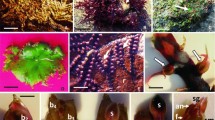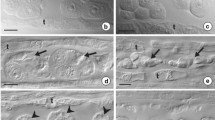Abstract
To determine a possible mechanism causing male and female sterility in Cryptomeria japonica male and female cones were collected from a C. japonica, tree, ShinDai2, that lacks pollen release and fertile seeds and specimens were processed to examine the development of pollen and female gametophytes using light microscopy and field emission scanning electron microscopy. Pre-meiotic development proceeded normally, but the formation of aberrant meiotic products was observed in cones of both sexes. In sterile microsporangia, heterogeneous microspore populations ranging from monads to polyads gave rise to mature pollen grains of non-uniform size. These pollen grains were covered with an amorphous layer and adhered to each other. In addition, they remained in the microsporangia and were not released even after the onset of pollen dissemination from fertile trees. In the ovules of sterile female cones, megaspores with abnormal shapes, numbers, and sizes formed, and the development of female gametophytes was arrested at the free nuclear or archegonium formation stages. These gametophytes collapsed, and no fertile embryo was generated. Results indicate that meiotic defects are important in the sterility mechanism.




Similar content being viewed by others
References
Andersson EA (1947) Case of asyndesis in Picea abies. Hereditas 33:301–347
Bai X, Peirson BN, Dong F, Xue C, Makaroff CA (1999) Isolation and characterization of SYN1, a RAD21-like gene essential for meiosis in Arabidopsis. Plant Cell 11:417–430
Bhatt M, Lister C, Page T, Fransz P, Findlay K, Jones GH, Dickinson HG, Dean C (1999) The DIF1 gene of Arabidopsis is required for meiotic chromosome segregation and belongs to the REC8/RAD21 cohesin gene family. Plant J 19:463–472
Bretagnolle F, Thompson JD (1995) Tansley review no 78. Gametes with the somatic chromosome number: mechanisms of their formation and role in the evolution of autopolyploid plants. New Phytol 129:1–22
Chapman GP (1987) The tapetum. Int Rev Cytol 107:111–125
Cigan AM, Unger E, Xui R-J, Kendall T, Fox TW (2001) Phenotypic complementation of ms45 maize requires tapetal expression of MS45. Sex Plant Reprod 14:135–142
Dogra PD (1966) Embryogeny of the Taxodiaceae. Phytomorphology 16:125–141
El Maâtaoui M, Pichot C (2001) Microsporogenesis in the endangered species Cupressus dupreziana A. Camus: evidence for meiotic defects yielding unreduced and abortive pollen. Planta 213:543–549
Hashizume H (1962) Initiation and development of flower buds in Cryptomeria japonica. J Jpn Forest Soc 44:312–319
He C, Mascarenhas JP (1999) MEI1, an Arabidopsis gene required for male meiosis: isolation and characterization. Sex Plant Reprod 11:199–207
Ilarslan H, Horner HT, Palmer RG (1999) Genetics and cytology of a new male-sterile, female-fertile soybean mutant. Crop Sci 39:658–664
Inoue T, Osatake H (1988) A new drying method of biological specimens of scanning electron microscopy: The t-butyl alcohol freeze-drying method. Arch Histol Cytol 51:53–59
Ishizaki T, Koizumi K, Ikemori R, Ishiyama Y, Kushibiki E (1987) Studies of prevalence of Japanese cedar pollinosis among residents in a densely cultivated area. Ann Allergy 58:265–270
Kurmann MH (1990) Exine formation in Cunninghamia lanceolata (Taxodiaceae). Rev Palaeobot Palynol 64:175–179
Mascarenhas JP (1990) Gene activity during pollen development. Annu Rev Plant Physiol Plant Mol Biol 41:317–338
Nagao A, Sasaki S, Pharis RP (1989) Cryptomeria japonica. In: Halevy AH (ed) CRC handbook of flowering, vol 6. CRC, Boca Raton, pp 247–269
Nishihata S, Inouye S, Saiga N, Suzuki S, Murayama K, Yokoyama T, Saito Y (1999) Prevalence rate of allergy to Japanese cedar pollen in Tokyo—from field investigation in 1996 by Tokyo Japanese Cedar Pollen Allergy Measurements and Review Committee. Arerugi 48:597–604
Orr-Ewing AL (1977) Female sterility in Douglas fir. Silvae Genet 26:75–77
Pagliarini MS, De Freitas PM, Takayama SY, Batista LAR (1998) An original meiotic mutation in Paspalum regnellii. Sex Plant Reprod 11:17–21
Runquist EW (1968) Meiotic investigations in Pinus silvestris (L). Hereditas 60:77–128
Saito M, Taira H, Furuta Y (1998) Cytological and genetical studies on male sterility in Cryptomeria japonica D. Don. J Forest Res 3:167–173
Sakaguchi M, Inouye S, Taniai M, Ando S, Usui M, Matsuhasi T (1990) Identification of the second major allergen of Japanese cedar pollen. Allergy 45:309–312
Schneider H (1981) Plant anatomy and general botany. In: Clark G (ed) The staining procedures, 4th edn. Williams & Wilkins, Baltimore, pp 315–333
Siddiqi I, Ganesh G, Grossniklaus U, Subbiah V (2000) The dyad gene is required for progression through female meiosis in Arabidopsis. Development 127:197–207
Sing H, Chatterjee J (1963) A contribution to the life history of Cryptomeria japonica D. Don. Phytomorphology 13:429–445
Sone T, Komiyama N, Shimizu K, Kusakabe T, Morikubo K, Kino K (1994) Cloning and sequencing of cDNA coding for Cry j1, a major allergen of Japanese cedar pollen. Biochem Biophys Res Commun 15:619–625
Staiger CJ, Cande WZ (1993) Cytoskeletal analysis of maize meiotic mutants. In: Ormrod JC, Francis D (eds) Molecular and cell biology of the plant cell cycle. Kluwer, Dordrecht, pp 157–171
Stelly DM, Peloquin SJ (1985) Screening for 2n female gametophytes, female fertility, and 2x×4x crossability in potatoes (Solanum spp). Am Potato J 62:519–29
Taira H, Saito M, Furuta Y (1999) Inheritance of the trait of male sterility in Cryptomeria japonica. J Forest Res 4:271–273
Takaso T, Tomlinson PB (1989) Aspects of cone and ovule ontogeny in Cryptomeria (Taxodiaceae). Am J Bot 76:692–705
Uehara K, Sahashi N (2000) Pollen wall development in Cryptomeria japonica (Taxodiaceae). Grana 39:267–274
Wilson VR, Owens JN (2003) Histology of sterile male and female cones in Pinus monticola (western white pine). Sex Plant Reprod 15:301–315
Wilson ZA, Morroll SM, Dawson J, Swarup R, Tighe PJ (2001) The Arabidopsis MALE STERILITY 1 (MS1) gene is a transcription regulator of male gametogenesis, with homology to the PHD-finger family of transcription factors. Plant J 28:27–39
Wüthrich B (1989) Epidemiology of the allergic diseases: are they really on the increase? Int Arch Allergy Appl Immunol 90:3–10
Wüthrich B, Schindler C, Leuenberger P, Ackermann-Liebrich U (1995) Prevalence of atopy and pollinosis in the adult population of Switzerland (SAPALDIA study). Swiss study on air pollution and lung diseases in adults. Int Arch Allergy Appl Immunol 106:149–156
Yang M, Hu Y, Lodhi M, McCombie WR, Ma H (1999) The Arabidopsis SKP1-LIKE gene is essential for male meiosis and may control homologue separation. Proc Natl Acad Sci USA 96:11416–11421
Yasueda H, Yui Y, Shimizu T, Shida T (1983) Isolation and partial characterization of major allergen from Japanese cedar (Cryptomeria japonica) pollen. J Allergy Clin Immunol 71:77–86
Yokoyama T (1975) Embryogenesis and cone growth in Cryptomeria japonica. Bull Gov Forest Exp Stn 257:1–20
Yokoyama T (1997) The cause of self-sterilely in Cryptomeria japonica D. Don. J Jpn Forest Soc 59:389–390
Acknowledgements
This study was supported by funds from the Research Project for Utilizing Advanced Technologies in Agriculture, Forestry and Fisheries. We wish to thank Dr. M. Yoshida, Graduate School of Bioagricultural Sciences, Nagoya University, for technical assistance with light microscopy and field emission scanning electron microscopy. We are also grateful to S. Akasaka and S. Miura, Faculty of Agriculture, Niigata University, for assistance in preparing samples for microscopic observation.
Author information
Authors and Affiliations
Corresponding author
Rights and permissions
About this article
Cite this article
Hosoo, Y., Yoshii, E., Negishi, K. et al. A histological comparison of the development of pollen and female gametophytes in fertile and sterile Cryptomeria japonica . Sex Plant Reprod 18, 81–89 (2005). https://doi.org/10.1007/s00497-005-0003-3
Received:
Accepted:
Published:
Issue Date:
DOI: https://doi.org/10.1007/s00497-005-0003-3




